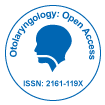The Tests and Treatment Procedures Followed By Pediatric Otolaryngologist
Received: 03-Jan-2022 / Manuscript No. ocr-22-53298 / Editor assigned: 05-Jan-2022 / PreQC No. ocr-22-53298 / Reviewed: 21-Jan-2022 / QC No. ocr-22-53298 / Revised: 25-Jan-2022 / Manuscript No. ocr-22-53298 / Accepted Date: 25-Jan-2022 / Published Date: 31-Jan-2022 DOI: 10.4172/2161-119X.1000443
A pediatric otolaryngologist (pronounced “ōtō-lar-en-gäl-e-jest”), or ear, nose and throat (ENT) doctor, specializes in the clinical and surgical care of babies, kids and adolescents with issues that have an effect on the ears, nostril, throat, head and neck. Pediatric otolaryngologists diagnose and deal with a number of health conditions, along with tonsillitis, laryngomalacia (a beginning defect), ear infections, and sleep apnea [1-2].
What situations and sicknesses does a pediatric otolaryngologist deal with?
A pediatric otolaryngologist treats situations and sicknesses along with:
Ear situations along with ear infections, listening to loss, stability issues, ruptured eardrum, ringing in the ears (tinnitus), cholesteatoma (abnormal skin increase in the ear), benign (noncancerous) growths, and congenital issues and deformities of the outer and inner ear.
Head and neck situations along with tumors of the parotid, thyroid and parathyroid glands; sleep apnea; head or neck masses; hemangiomas (benign blood vessel tumors) and vascular malformations; and facial irregularities, deformities or injuries.
Nose situations along with sinusitis, deviated septum, chronic or recurring nosebleeds, nasal polyps, nasal obstructions, and lack of smell.
Speech and hearing issues along with hypernasal speech, listening to loss, and vocal cord paralysis or lesions.
Throat situations along with voice and swallowing issues, pediatric gastroesophageal reflux disease (GERD), laryngopharyngeal reflux (LPR), and tonsil and adenoid infections.
What tests does a pediatric otolaryngologist carry out? A pediatric otolaryngologist can order or carry out an extensive style of diagnostic and screening exams, along with:
Biopsies along with elimination of tissue from the thyroid or different regions of the head and neck. General health exams along with physical exam of the ears, nose, throat, head and neck; blood exams; microorganism (bacteria) cultures along with group A Streptococcus; and allergy patch pores and skin tests.
GERD exams along with pH probe, barium swallow or upper GI series, technetium gastric emptying study, and endoscopy with biopsy.
• Hearing and speech reviews along with otoscopy, tympanography and audiography.
• Imaging checks along with X-rays and computed tomography (CT) scans.
• Scope tests along with endoscopy (of the esophagus), otoscopy (of the ear), bronchoscopy (of the airlines and lungs), and laryngoscopy (of the back of the throat and voice box).
• Sleep research along with polysomnogram (PSG).
Challenges in pediatric otolaryngology: Pediatric otolaryngology changed into born out of a want for professionals to deal with and control congenital complications in babies and kids [3]. Since its inception, this area has made fast advances with revolutionary technological breakthroughs, medical discoveries, and healing interventions. However, as mentioned above, there are a few splendid demanding situations, people and it’s vital that we experience on our current fulfilment and appearance to increase the modern boundaries. With technology and medication turning into increasingly interdisciplinary, we're poised to make fast advances and are positioned in a tremendous role to conquer modern demanding situations and find out new ones [4].
References
- Wold SM, Derkay CS, Darrow DH, Proud V (2009) Role of the Pediatric Otolaryngologist in Diagnosis and Management of Children with Mucopolysaccharidoses. Int J Pediatr Otorhinolaryngol 74:27-31.
- Bhutta MF (2010) Chronic Otitis Media in Mucopolysaccharidosis May Not Be Due to Eustachian Tube Dysfunction. Int J Pediatr Otorhinolaryngol 75:140-141.
- Papsin BC, Pengilly AJ, Leighton SE (1996) The Developing Role of a Paediatric Voice Clinic: A Review of Our Experience. J Laryngol Otol 110:1022-1026.
- Coticchia JM, Cohen D, Sachdeva L (2013) Grand Challenges in Pediatric Otolaryngology. Front Pediatr 1:10.
Indexed at, Google Scholar, Crossref
Indexed at, Google Scholar, Crossref
Indexed at, Google Scholar, Crossref
Citation: Adunka OF (2022) The Tests and Treatment Procedures Followed by Pediatric Otolaryngologist. Otolaryngol (Sunnyvale) 12: 443. DOI: 10.4172/2161-119X.1000443
Copyright: © 2022 Adunka OF. This is an open-access article distributed under the terms of the Creative Commons Attribution License, which permits unrestricted use, distribution, and reproduction in any medium, provided the original author and source are credited.
Select your language of interest to view the total content in your interested language
Share This Article
Recommended Journals
Open Access Journals
Article Tools
Article Usage
- Total views: 2157
- [From(publication date): 0-2022 - Dec 10, 2025]
- Breakdown by view type
- HTML page views: 1500
- PDF downloads: 657
